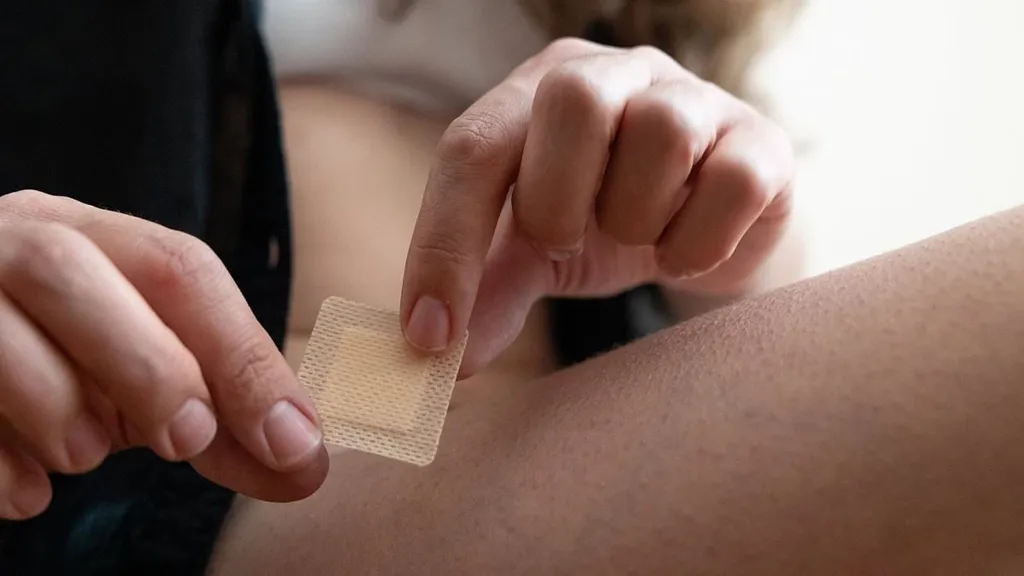They can be painful, invasive and a source of considerable stress - but biopsies are a crucial part of diagnosing serious illness.
By removing small samples of tissue from the affected body part and studying them under a microscope, doctors can determine if someone has, for example, cancer, a liver infection, or even whether they're suitable for a life-saving organ transplant.
More than 100,000 biopsies a year are carried out on the NHS just for suspected prostate cancer alone.
But some biopsies could soon be a thing of the past thanks to new high-tech patches, which can accurately detect certain health problems without doctors having to cut out any tissue to study more closely in the laboratory. It could mean the procedures are less painful, with a reduced risk of infection from incisions currently made to take samples.
The experimental patch, which costs just £10 to manufacture, is about the size of a small postage stamp. It has 16 million tiny silicon needles on its surface, and each needle is 1,000 times smaller than the width of a human hair.
Unlike normal patches that are stuck on the skin, the cutting-edge version is placed inside the body, on the surface of the affected organ or tissue itself, for just seconds. This creates a 'fingerprint' of molecules that can then be analysed.
The patch could prove particularly useful during surgery to remove a brain tumour, for example.
Currently, such surgery can be held up while a biopsy is rushed to the pathology lab to see if the growth is cancerous or not. The answer may help determine how much healthy brain tissue surgeons remove (to ensure all the cancer cells are taken out) and whether additional treatment, such as radiotherapy, is needed.
At the moment, the wait can be at least an hour - while the patient remains under general anaesthetic on the operating table.
Scientists at King's College London and Edinburgh University who are developing the new patch claim it could remove the need to extract tissue and cut the time it takes to get results to 20 minutes.
'It can be very difficult to tell if tissue is cancerous and what the next steps should be,' says Paul Brennan, a professor of clinical and experimental neurosurgery at Edinburgh University and one of the lead researchers.
'This can mean that an operation may be held up and a patient is potentially waiting on an operating table under anaesthesia while we wait for feedback.'
Dr Ciro Chiappini, a senior lecturer at King's College London
'If this patch can tell if a tumour is present, it has the potential to guide brain surgery in real time.'
Scientists behind the invention hope it could also be placed inside the mouth - on the inner cheek, for example - to check if a suspicious-looking lesion is cancerous.
At the moment, a lesion is visually monitored and a biopsy is only ordered if there is a noticeable change in its size and shape.
Even diabetes patients might eventually benefit, researchers predict, as the patches could monitor how ulcerated wounds (caused by poor circulation from high blood sugar levels) are healing by checking on molecular changes.
An estimated 200 people a week in the UK currently undergo limb amputations due to diabetes-related ulcers that do not heal.
The secret to the new patch is that, unlike skin patches, instead of puncturing delicate tissue, or causing any kind of damage, the silicon needles absorb a cocktail of fats, proteins and fragments of genetic material from the area.
Once these vital substances have been soaked up - which takes only about ten seconds - the patch is removed and taken to the lab.
There it is placed inside a mass spectrometer, a machine that works out the molecular make-up of the materials it has absorbed.
An artificial intelligence program then analyses the results.
The researchers tested the patch on tissue samples previously taken from patients with brain cancer.
The results, just published in Nature Nanotechnology, showed the patch was just as accurate as standard biopsies at pinpointing tumours in the brain and analysing their make-up.
'Because the silicon needles are porous, they soak up molecules from within the cells like a sponge without causing damage to the cell walls,' said lead study author Dr Ciro Chiappini, a senior lecturer in nanomaterials and biointerfaces at King's College London.
In mouth cancer, the patch could spot tumours sooner and also prevent unnecessary repeat biopsies.
Dr Chiappini said: 'Our patch could prevent misdiagnosis and over-treatment by quickly assessing the lesions in situ to determine if they are cancerous or not.'
Scientists are exploring the potential for microneedle patches to identify tyrosinase, an enzyme that is a key marker for malignant melanoma - a type of skin cancer that kills around 2,300 people a year.
By measuring the enzyme's levels directly in the skin, researchers are hoping they will be able to use the technology to detect malignant melanoma early, before the obvious signs develop.
And researchers at Swansea University are developing a microneedle skin patch to detect Alzheimer's and Parkinson's diseases.
Hundreds of tiny needles penetrate the top layer of the skin and soak up various biomarkers in the interstitial fluid, the fluid that surrounds cells in the body, including the skin. This is the same principle used for continuous blood-sugar monitors.
The samples are then analysed for biomarkers that can indicate the very early stages of either brain disease.
